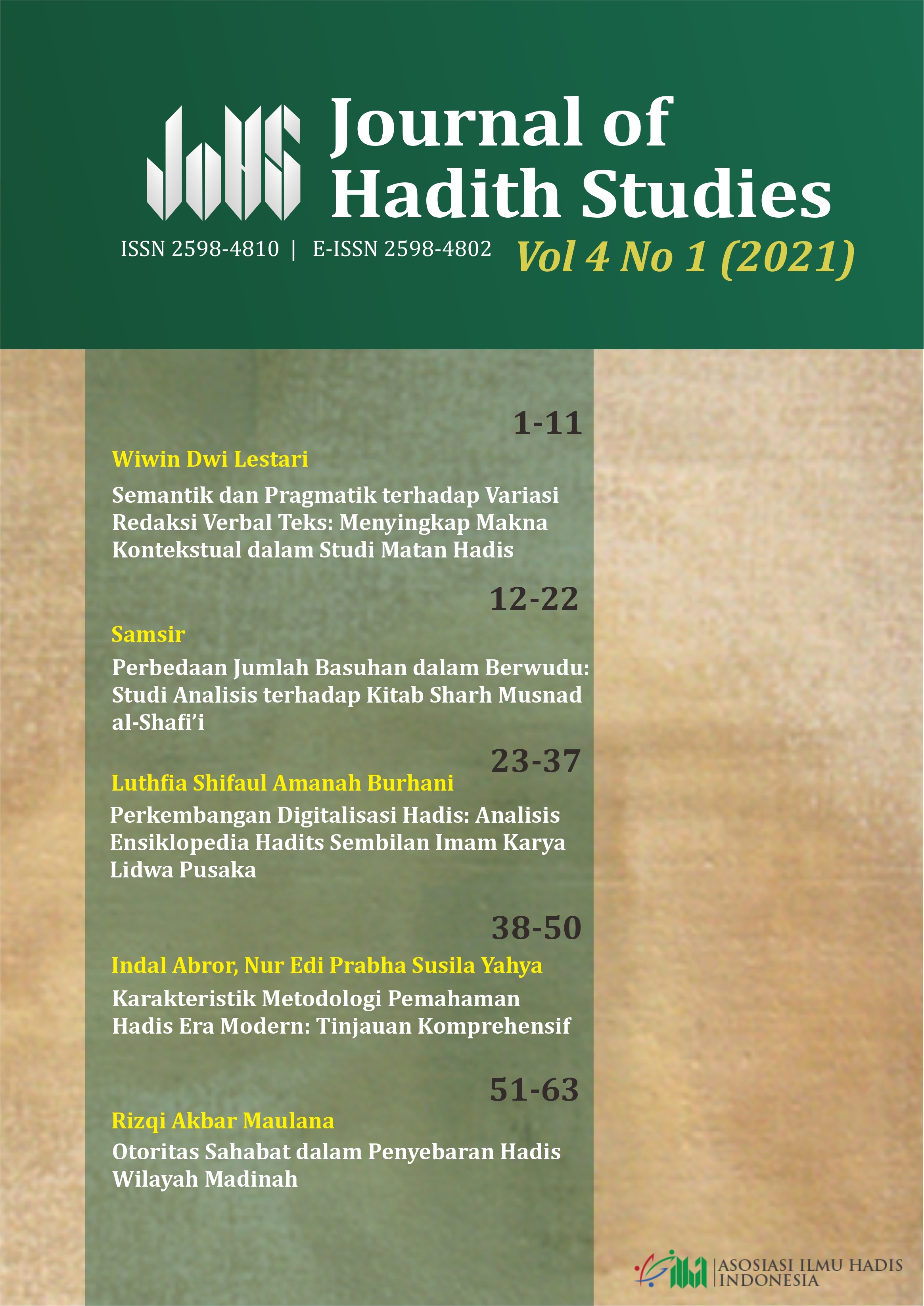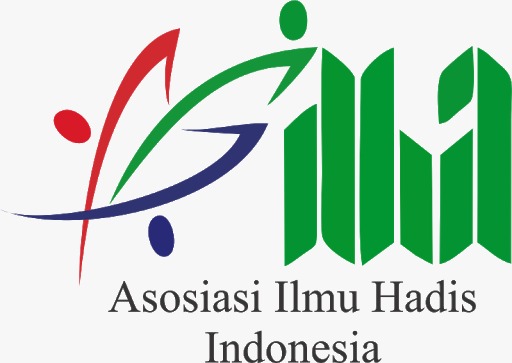Perkembangan Digitalisasi Hadis: Analisis Ensiklopedia Hadits 9 Imam Karya Lidwa Pusaka
DOI:
https://doi.org/10.32506/johs.v4i1-03Keywords:
Digital Transformation, Hadith Applications, Hadith Takhrij, Encyclopedia of Hadith Kitab 9 Imam, Hadith ValidityAbstract
The study of hadith continues to evolve, particularly in response to the rapid advancement of the digital age and technological innovation. This development is evident in the increasingly accessible methods of retrieving hadith, which were once obtained through manual efforts but are now facilitated by various digital applications and software. Mausu'ah al-Hadith al-Sharif and the digital library Maktabah Syamilah are among the most comprehensive tools. Additionally, several hadith applications featuring Indonesian language support have emerged, one of which is the Encyclopedia of Hadith: The Nine Imams’ Collection, developed by Lidwa Pustaka in collaboration with Saltanera Teknologi. This article adopts a descriptive approach grounded in literature review to explore the use of such applications, focusing on analyses drawn from recent scholarly articles. One key finding highlights that the Encyclopedia of Hadith: The Nine Imams’ Collection provides considerable convenience in hadith authentication (takhrij) and is widely used as a digital reference in both da’wah and educational contexts. Nonetheless, the ease of access also carries potential risks, particularly concerning the authenticity of hadiths disseminated through digital platforms. Thus, it is crucial to foster a strong understanding of hadith and its sciences, instill values of honesty and integrity in hadith research and dissemination, and promote the use of credible applications such as the Hadith Encyclopedia as foundational tools in digital hadith studies
Downloads
References
Aksin, N., & Baedowi, S. (2020). Berita Bohong (Hoax) Perspektif Hukum Islam. Jurnal Informatika UPGRIS, 6(1). https://doi.org/10.26877/jiu.v6i1.6792
al-Shalih, S. (1988). ’Ulum al-Hadits Wa Mushthalahuh. Dar al-’Ilm li al-Malayin.
al-Suyūṭī, J. al-Dīn. (1994). Tadrib al-Rāwī fī Syarḥ Taqrīb al-Nawāwī. Maktabah al-Kauṡar.
al-Sibā’ī, M. (n.d.). Al-Sunnah wa Makānatuhā fī al-Tasyrī’ al-Islāmī. Dār al-Warrāq.
al-Syāfi’ī, M. I. I. (1980). Musnad al-Syāfi’ī. Dār al-Kutub al-’Ilmiyyah.
Azami, M. M. (2020). Hadis Nabawi dan Sejarah Kodifikasinya (A. M. Ya’qub, Trans.). Pustaka Firdaus.
Batubara, H. H. (2017). Pemanfaatan Ensiklopedi Hadis Kitab 9 Imam sebagai Media dan Sumber Belajar Hadis. Muallimuna: Jurnal Madrasah Ibtidaiyah, 2(2). http://dx.doi.org/10.31602/muallimuna.v2i2.769
Bullah, H. (2022). Metode Pemahaman Hadis; Analisis Mukhtalif al-Hadis. Tahdis: Jurnal Kajian Ilmu Al-Hadis, 13(1).
Dadah, Asram, & Ecep Ismail. (2018). Lidwa Pusaka Application in Learning Hadith. ICONQUHAS. https://doi.org/10.4108/eai.2-10-2018.2295443
Dalimunthe, R. P. (2019). Efektivitas aplikasi Lidwa Pusaka terhadap pembelajaran hadits dan ilmu hadits di jurusan ilmu hadis. [Laporan Penelitian]. UIN Sunan Gunung Djati.
Fauzi, I. (2020). Hadis dari Klasik Literal ke Portable Digital: Telaah Aplikasi Smartphone Mausu’ah al-Hadis al-Syarif Islamweb. Riwayah: Jurnal Studi Hadis, 6(1).
Fikriyyah, D. U. (2016). Telaah Aplikasi Hadis (Lidwa Pusaka). Jurnal Studi Ilmu-Ilmu al-Qur’an Dan Hadis, 17(2).
Hamid, A. (2024). Peran Website dalam Penyebaran Hadis di Era Digital. El Nubuwwah: Jurnal Studi Hadis, 2(2).
Idri. (2020). Problematika Autentisitas Hadis Nabi Dari Klasik Hingga Kontemporer. Kencana.
Ismail, M. S. (1992). Metode Penelitian Hadis Nabi. Bulan Bintang.
Maulid, P. H. (2022). Analisis Aplikasi Ensiklopedia Hadis 9 Imam Versi Android sebagai Sarana Dakwah di Media Sosial. Jurnal Penelitian Ilmu Ushuluddin, 2(2). https://doi.org/10.15575/jpiu.v2i2.14393
Mudin, M. (2019). Islam virtual: Diskursus Hadis, Otoritas, dan Dinamika Keberislaman di Media Sosial (N. Afifah, Ed.). Bildung Nusantara.
Muhlis, W., & Hajar, I. (2023). Hadith And Technological Challenges In The Contemporary Era. Al-Bukhari: Jurnal Ilmu Hadis, 6(2).
Muslim Ibn al-Hajjaj. (2014). Shahih Muslim. Dar al-Tashil.
Nikmah, S. (2022). Perkembangan Kajian Hadis di Era Digital. Jurnal An-Nuha, 9(2).
@pustaka M2HM. (2019). Postingan Pustaka M2HM Ensiklopedia Islam Aswaja [Facebook]. https://www.facebook.com/PustakaM2HM/posts/memotong-hadis-demi-nafsuasli-hadis-yang-ada-di-meme-di-bawah-ini-adalah-seperti/2163088117329347/
Rosyad, S., & Alif, M. (2023). Hadis di Era Digital: Tantangan dan Peluang Penggunaan Teknologi dalam Studi Hadis. Jurnal Ilmu Agama, 24(2).
Setiawan, R. A. (2024). Resepsi Hadis pada Platform Media Sosial: Studi Kritis tentang Penyebaran dan Interpretasi Hadis di Era Digital. Musnad: Jurnal Ilmu Hadis, 2(1).
Suryadilaga, M. A. (2020). Hadis dan Media (Sejarah, Perkembangan, dan Transformasinya). Kalimedia.
Ummah, S. S. (2019). Digitalisasi Hadis (Studi Hadis di Era Digital). Diroyah: Jurnal Ilmu Hadis, 4(1).
Wahid, A. & Junida. (2023). Urgensitas Pembelajaran Ilmu Hadis di Era Digital. EL-SUNAN JOURNAL OF HADITH AND RELIGIOUS STUDIES, 1(1). https://doi.org/10.22373/el-sunan.v1i1.3464
Wendry, N. (2022). Epistimologi Studi Hadis Kawasan: Konsep, Awal Kemunculan, dan Dinamika. Al-Quds: Jurnal Studi Alquran Dan Hadis, 6(3).
Zed, M. (2004). Metode Penelitian Kepustakaan. Yayasan Pustaka Obor Indonesia.
Downloads
Published
Issue
Section
License
Copyright (c) 2021 Luthfia Shifaul Amanah Burhani (Author)

This work is licensed under a Creative Commons Attribution-ShareAlike 4.0 International License.















